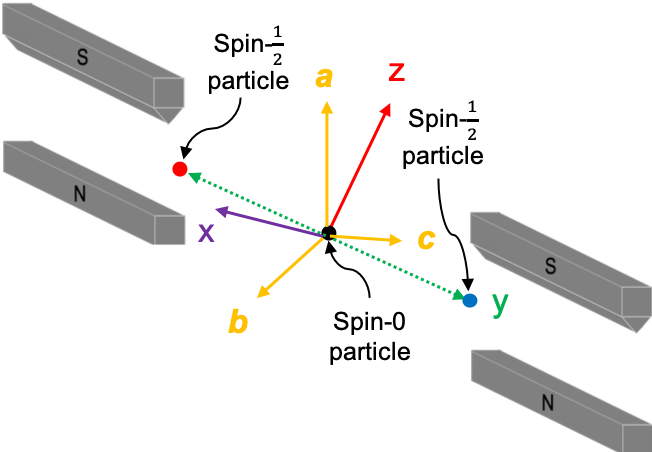Bell’s inequality, developed by John Bell in 1964, is a non-equal relation (between two expressions) that is based on the ERP paradox. It provides a way to determine whether quantum theory or the EPR paradox is correct. Bell suggested a unique way of measuring the spins of two spin- particles, which are generated from the decay of a spin-0 particle at rest: the two particles are to be passed through two Stern-Gerlach devices, each oriented along one of three non-orthogonal coplanar axes, which are specified by the unit vectors
,
and
.

The average values of the product of the spins in units of (denoted by
,
, and
) are then calculated. As derived in an earlier article (see eq227), quantum mechanics expresses the average values as:
For the ERP paradox, let’s equate a spin-up measurement to +1 and a spin-down measurement to -1. The average value of the product of the measured spins, for example in the and
directions, is:
where
i) is a hidden variable.
ii) is the probability density that is a function of
, with
and
.
iii) is a function of the axis of measurement and
. It is associated with the measurement made by the first Stern-Gerlach device, and has output values of
.
iv) is a function of the axis of measurement and
. It is associated with the measurement made by the second Stern-Gerlach device, and has output values of
.
From experiments, we know that
Substitute eq230 in eq229
Similarly, and
. Therefore,
Since , we can rearrange the above equation to
Taking the absolute value on both sides of the above equation and using the relation

Question
Why is ?
Answer
For all , we have
. Therefore,
or simply
, where we have use the identity of
.
Since
Since and
, we can ignore the absolute value sign on RHS of the above equation:
Substituting and
into the above equation gives
Eq232 is the Bell’s inequality, which is based on the ERP paradox.
To show that quantum mechanics is incompatible with Bell’s inequality, we let , i.e.
bisects
. From eq228,
Substituting eq233 and eq234 in eq232 yields , which is inconsistent with Bell’s inequality. Therefore, it is possible to experimentally measure the spins of the two particles at non-orthogonal angles to test the predictions of quantum theory versus the ERP paradox. In fact, the results of all experiments conducted at non-orthogonal angles were in agreement with quantum mechanics. This implies that all local hidden-variable hypotheses are invalid.